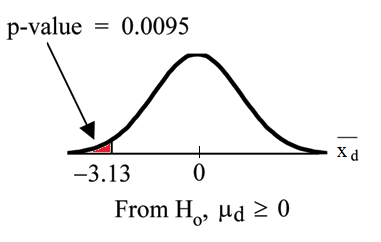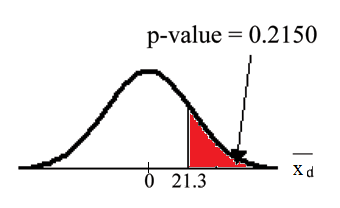| << Chapter < Page | Chapter >> Page > |
In a hypothesis test for matched or paired samples, subjects are matched in pairs and differences are calculated. The differences are the data. Thepopulation mean for the differences, , is then tested using a Student-t test for a single population mean with degrees of freedom where is the number of differences.
A study was conducted to investigate the effectiveness of hypnotism in reducing pain. Results forrandomly selected subjects are shown in the table. The "before" value is matched to an "after" value and the differences are calculated. The differences have a normal distribution.
| Subject: | A | B | C | D | E | F | G | H |
|---|---|---|---|---|---|---|---|---|
| Before | 6.6 | 6.5 | 9.0 | 10.3 | 11.3 | 8.1 | 6.3 | 11.6 |
| After | 6.8 | 2.4 | 7.4 | 8.5 | 8.1 | 6.1 | 3.4 | 2.0 |
Are the sensory measurements, on average, lower after hypnotism? Test at a 5% significance level.
Corresponding "before" and "after" values form matched pairs. (Calculate "sfter" - "before").
| After Data | Before Data | Difference |
|---|---|---|
| 6.8 | 6.6 | 0.2 |
| 2.4 | 6.5 | -4.1 |
| 7.4 | 9 | -1.6 |
| 8.5 | 10.3 | -1.8 |
| 8.1 | 11.3 | -3.2 |
| 6.1 | 8.1 | -2 |
| 3.4 | 6.3 | -2.9 |
| 2 | 11.6 | -9.6 |
The data for the test are the differences:{0.2, -4.1, -1.6, -1.8, -3.2, -2, -2.9, -9.6}
The sample mean and sample standard deviation of the differences are: and Verify these values.
Let be the population mean for the differences. We use the subscript to denote "differences."
Random Variable: = the mean difference of the sensory measurements
Distribution for the test: The distribution is a student-t with . Use . (Notice that the test is for a single population mean.)
Calculate the p-value using the Student-t distribution:
Graph:

is the random variable for thedifferences.
The sample mean and sample standarddeviation of the differences are:
Compare and the p-value: and . .
Make a decision: Since , reject .
This means that and there is improvement.
Conclusion: At a 5% level of significance, from the sample data, there is sufficient evidence to conclude that the sensory measurements, on average, are lower afterhypnotism. Hypnotism appears to be effective in reducing pain.
STAT and arrow over to
TESTS . Press
2:T-Test . Arrow over to
Data and press
ENTER . Arrow down and enter
0 for
, the name of the list where you put
the data, and
1 for Freq:. Arrow down to
μ : and arrow over to
<
. Press
ENTER . Arrow down to
Calculate and press
ENTER . The p-value is
0.0094 and the test statistic is -3.04. Do these instructions again exceptarrow to
Draw (instead of
Calculate ). Press
ENTER .A college football coach was interested in whether the college's strength development class increased his players' maximum lift (in pounds) on the benchpress exercise. He asked 4 of his players to participate in a study. The amount of weight they could each lift was recorded before they took the strength developmentclass. After completing the class, the amount of weight they could each lift was again measured. The data are as follows:
| Weight (in pounds) | Player 1 | Player 2 | Player 3 | Player 4 |
|---|---|---|---|---|
| Amount of weighted lifted prior to the class | 205 | 241 | 338 | 368 |
| Amount of weight lifted after the class | 295 | 252 | 330 | 360 |
The coach wants to know if the strength development class makes his players stronger, on average.
Record the differences data. Calculate the differences by subtracting the amount of weight lifted prior to the class from the weight lifted after completing the class. Thedata for the differences are: {90, 11, -8, -8}. The differences have a normal distribution.
Using the differences data, calculate the sample mean and the sample standard deviation.
Using the difference data, this becomes a test of a single __________ (fill in the blank).
Define the random variable: mean difference in the maximum lift per player.
The distribution for the hypothesis test is .
Graph:

Calculate the p-value: The p-value is 0.2150
Decision: If the level of significance is 5%, the decision is to not reject the null hypothesis because .
What is the conclusion?
means; At a 5% level of significance, from the sample data, there is not sufficient evidence to conclude that the strength development class helped to make the players stronger, on average.
Seven eighth graders at Kennedy Middle School measured how farthey could push the shot-put with their dominant (writing) hand and their weaker (non-writing) hand. They thought that they could push equal distances with eitherhand. The following data was collected.
| Distance (in feet) using | Student 1 | Student 2 | Student 3 | Student 4 | Student 5 | Student 6 | Student 7 |
|---|---|---|---|---|---|---|---|
| Dominant Hand | 30 | 26 | 34 | 17 | 19 | 26 | 20 |
| Weaker Hand | 28 | 14 | 27 | 18 | 17 | 26 | 16 |
Conduct a hypothesis test to determine whether the mean difference in distances between the children's dominant versus weaker hands is significant.
What is your conclusion?
: equals 0; : does not equal 0; Do not reject the null; At a 5% significance level, from the sample data, there is not sufficient evidence to conclude that the mean difference in distances between the children's dominant versus weaker hands is significant (there is not sufficient evidence to show that the children could push the shot-put further with their dominant hand). Alpha and the p-value are close so the test is not strong.

Notification Switch
Would you like to follow the 'Quantitative information analysis iii' conversation and receive update notifications?